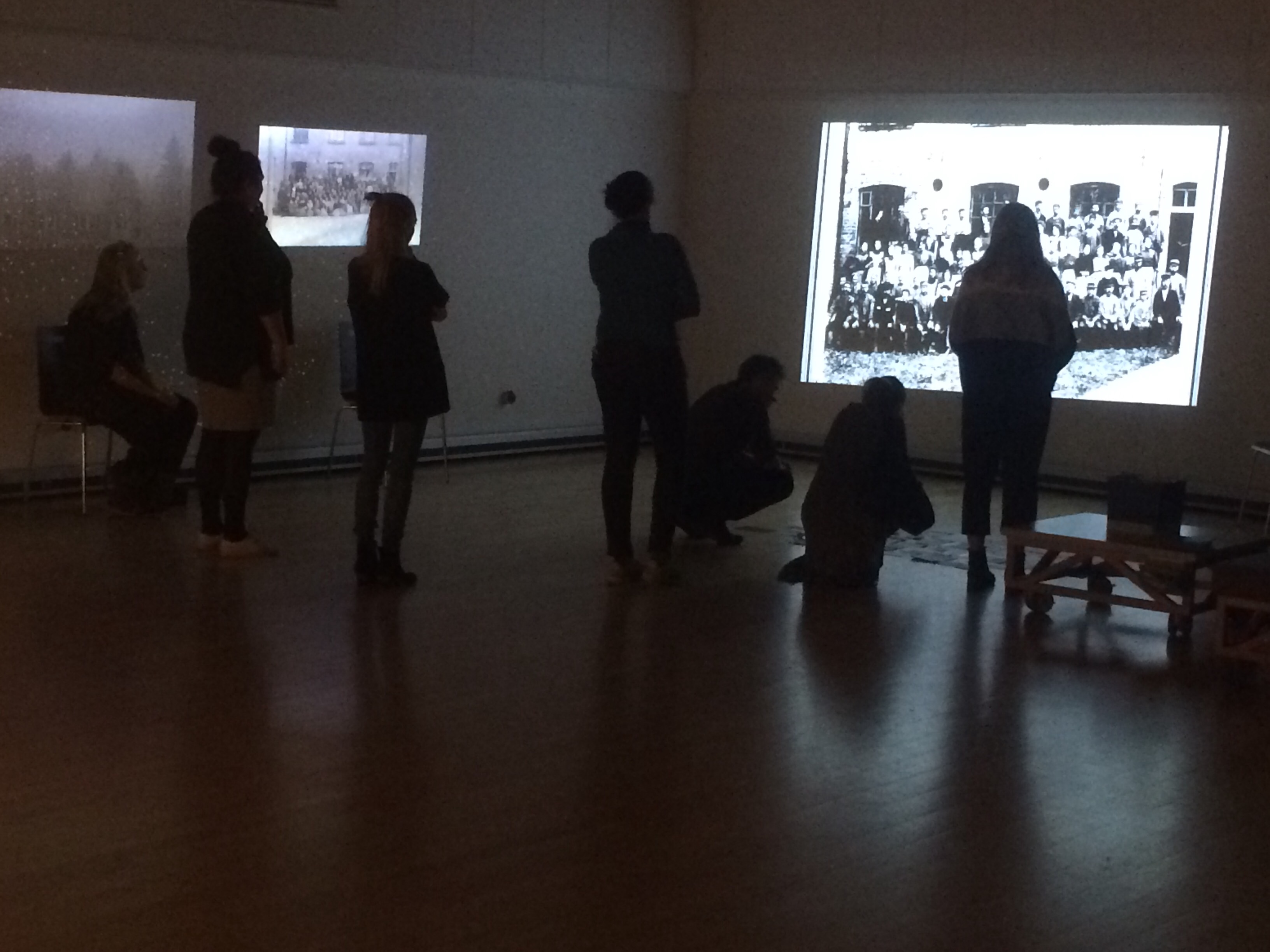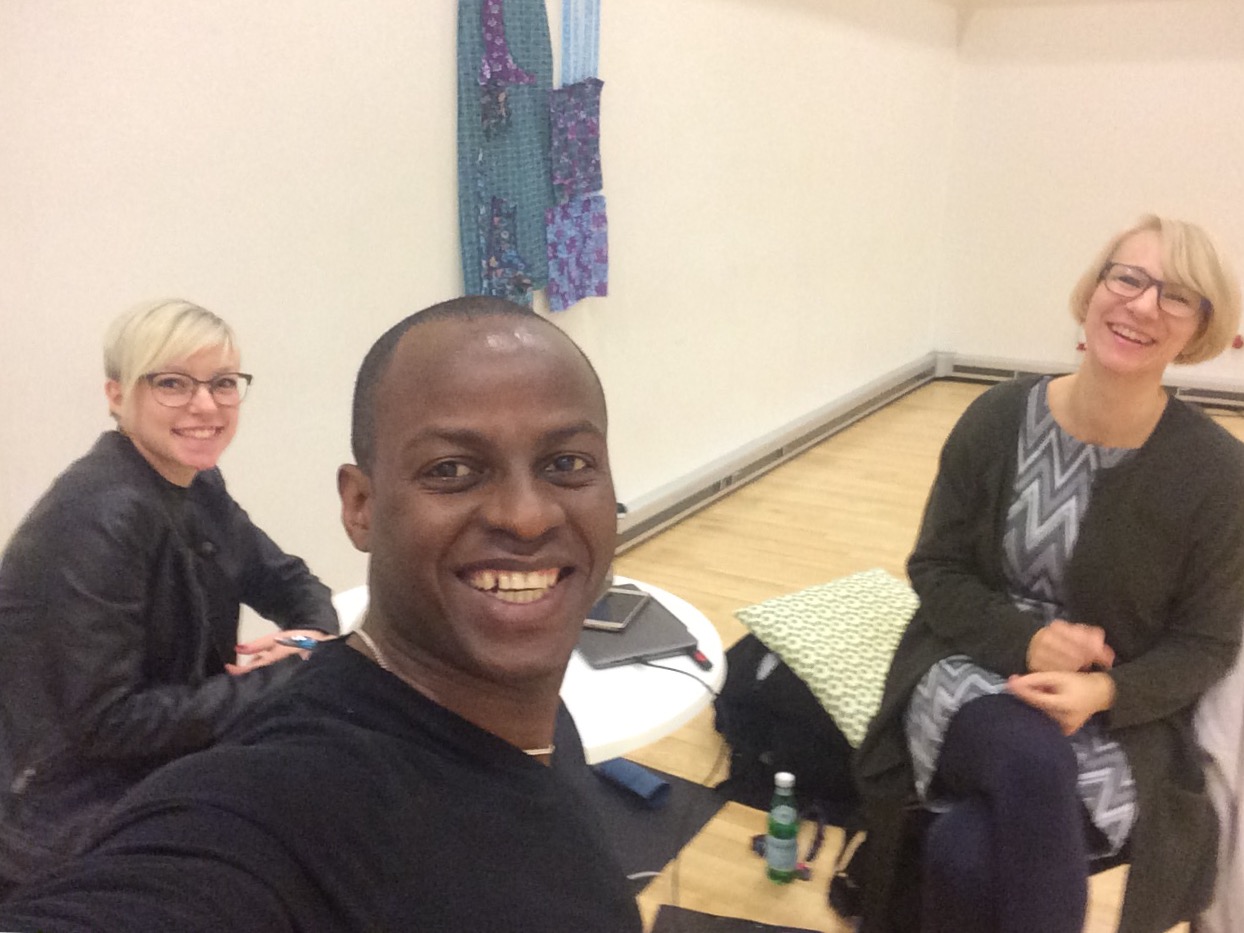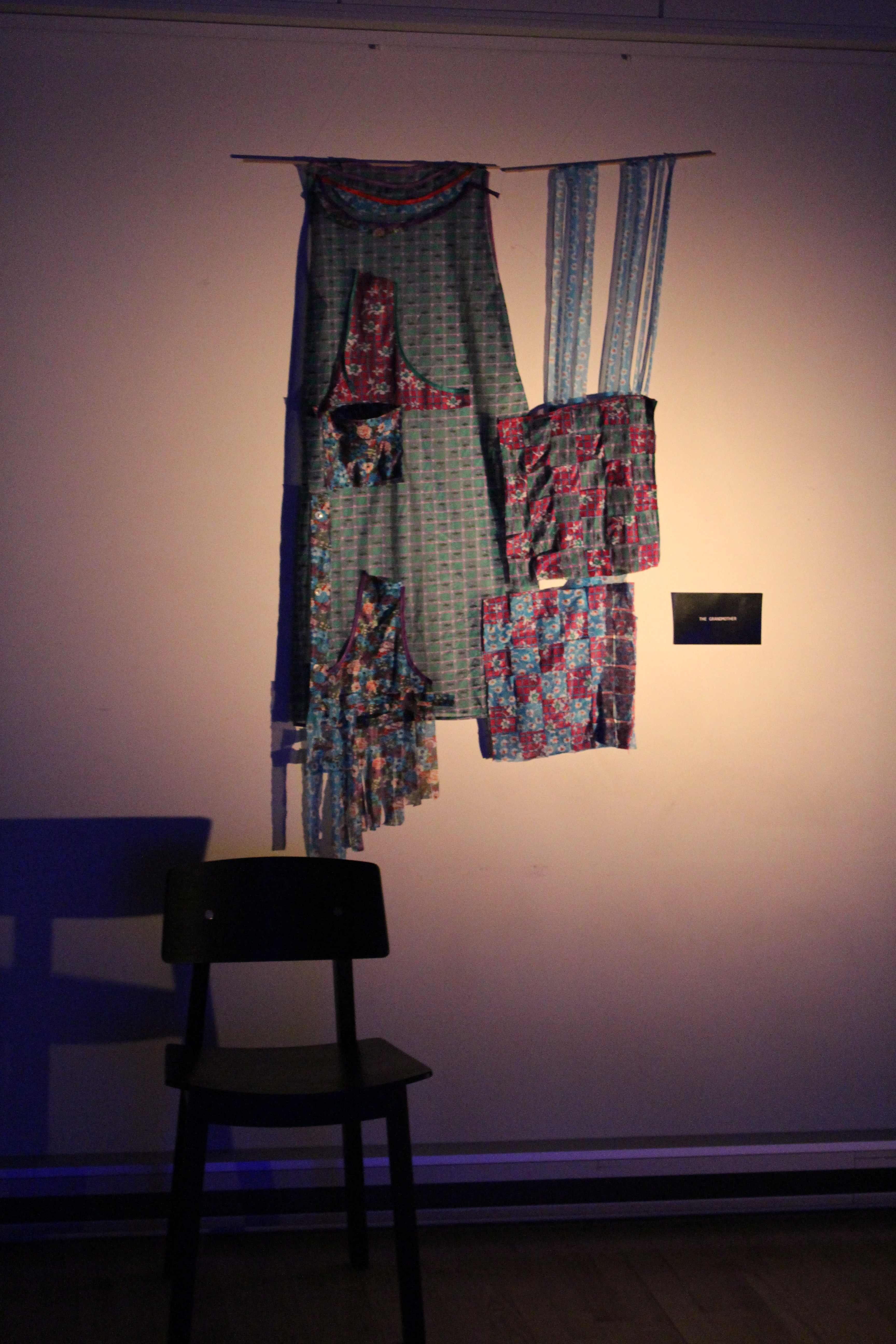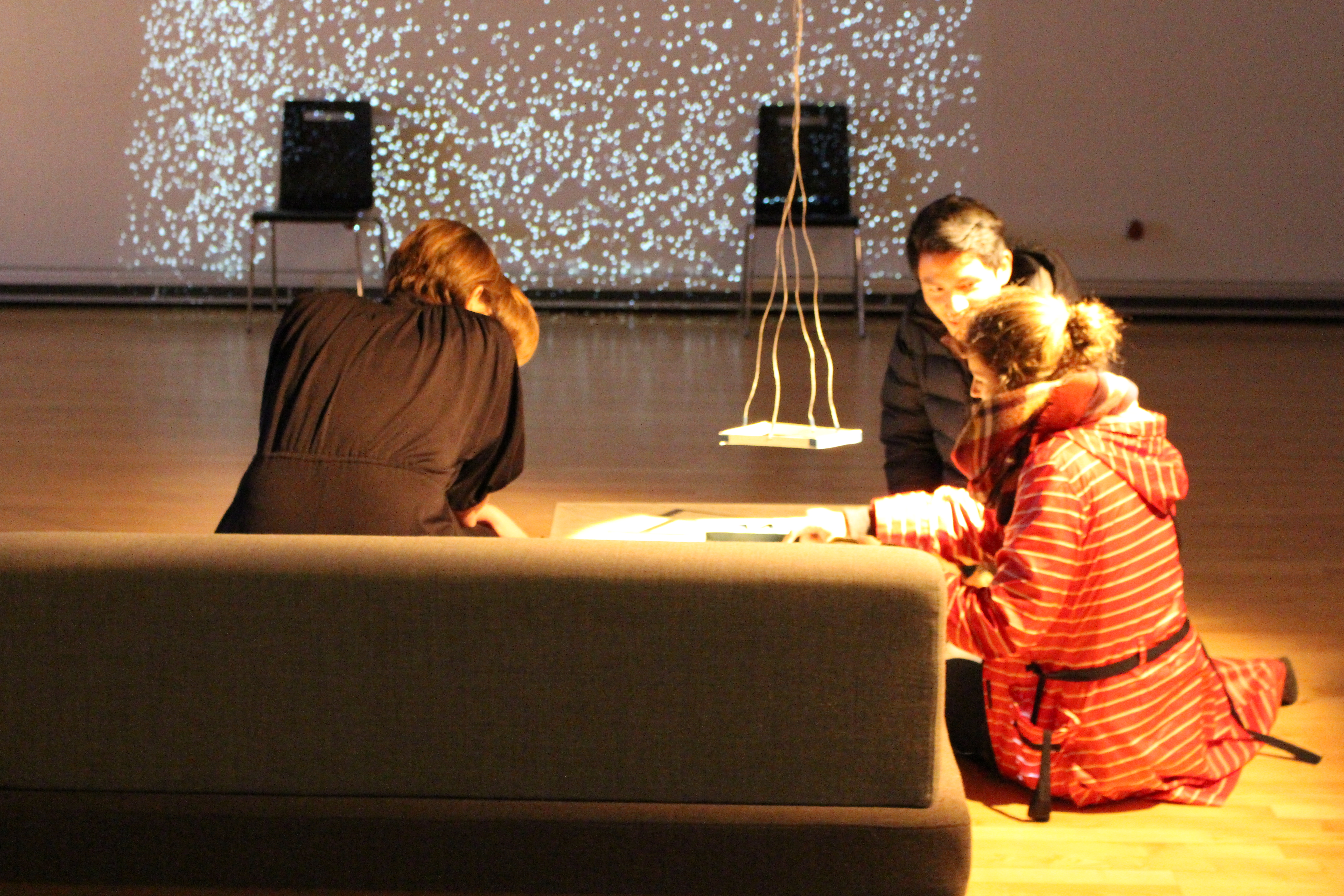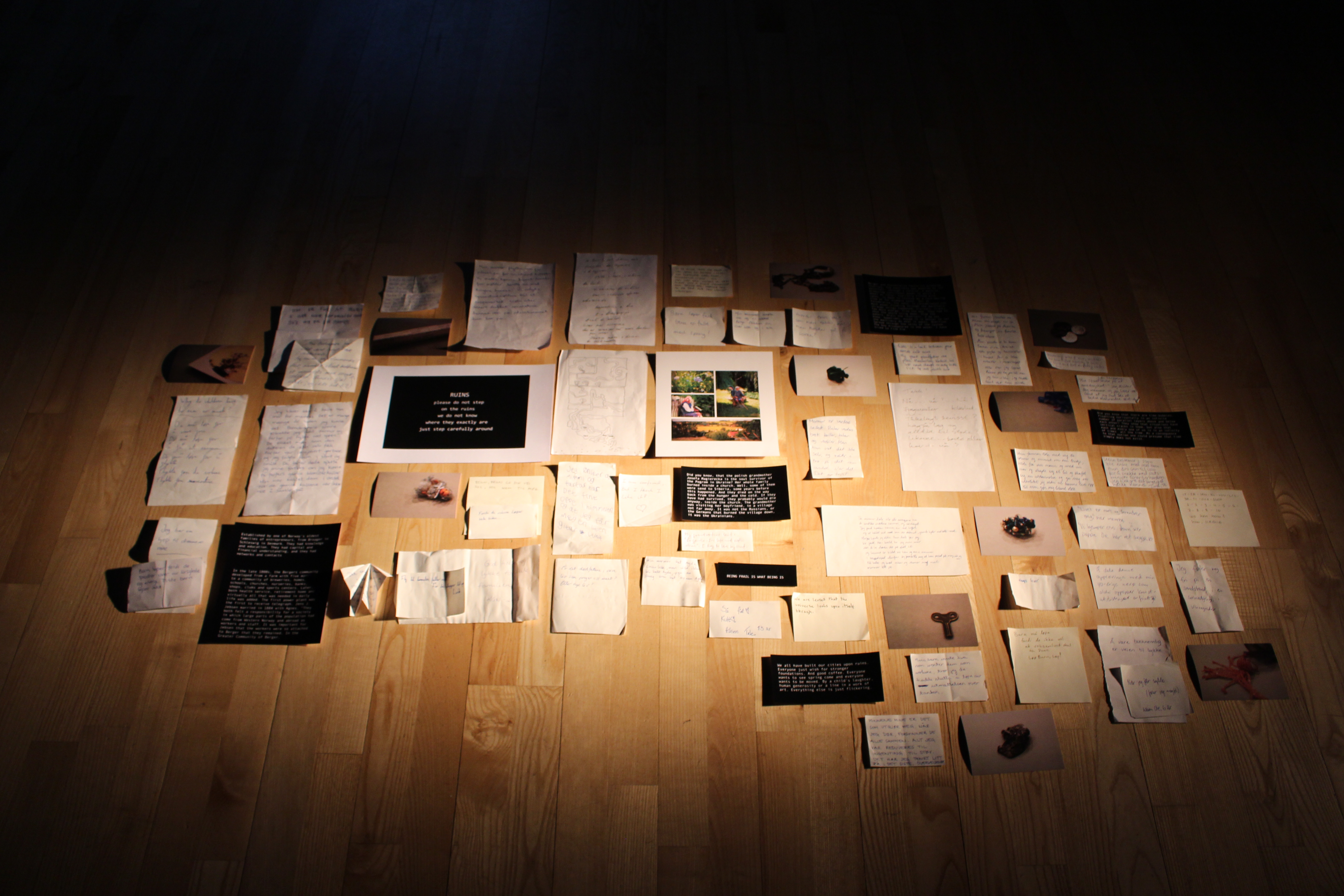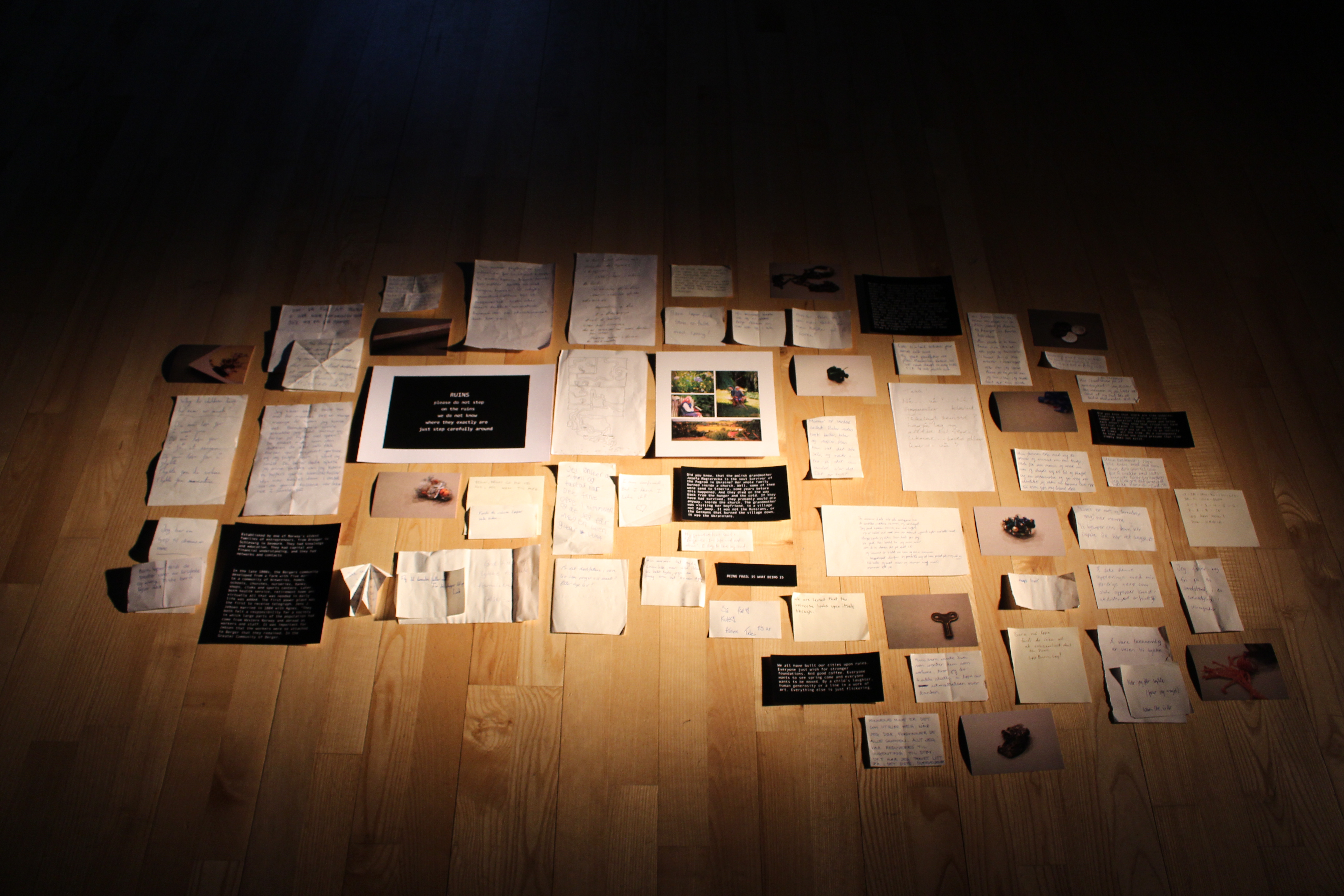Ruins
- Researching Interactive Strategies
Research in 2017 Artistic Practice Program
Seachange Lab
November 2017, Aarhus, Denmark
Joanna Magierecka
The experiment departs from an idea that the audience, through interweaving of different and diverging fragments, through forming their own personal performance dramaturgy and hence experience, and by sharing their stories and experiences, will create an understanding of others as well as their experience. In that lies a possibility for shared Story, a collective Story, crossing borders, heritage, History and personal experience. Using some of the elements from the installation Ruins (Fossekleiva kultursenter, Summer 2017) I want to research how to facilitate this interweaving process, through researching interactive strategies within the installation.
During the series of experiments, it became clear that the performer was the easiest way to create connections between the content and the audience, but problematic in its nature. Given enough time, creating a space containing micro universes, and presenting different strategies for investigating and sharing actually had the same impact as the performer.
Framing the Experiment
Through continuous communication with the project manager, facilitator and dramaturg – Kathrine Lund (Teater Seachange) previous to RAPP, I had created the following structure for the research:
- three focused experiments with emphasis on a performative, analogue, and digital interactive strategies Wednesday, November 22nd.
- open installation Saturday, November 25th.
The specific question we had asked ourselves was “how can we engage participants to share/share more/share in different ways through the installation?”
After each session with an audience during Wednesdays experiments, we had a discussion with the participants. All of the experiments were filmed, and we both facilitated and took notes of the discussions. By “we” I mean me, Maja Ravn – master candidate from the Department of Dramaturgy, Aarhus University and Sandro Masai, performance artist and designer. The comments from Wednesday were applied for Saturday´s open session.
On Friday, we had an additional discussion with two experts – Jacob Knudsen, researcher (creative communities and digital learning) and Alejandra Zaragoza Scherman, senior researcher at Psychology Institute, Aarhus University. Jacob introduced us to the term of micro universe – a space within the space, were the audience could retreat from the installation, remaining at the same time within its frame, and contributing through the interactive strategies.
The Installation
For the purpose of the experiment, I chose only some of the elements from the installation Ruins. I also created some new platforms to share through:
- Visual and textual content that the audience could respond to. That is, video films “Waving through walls”, “The Community” and “Ruins of childhood.” They were displayed on the walls, the first one separate, the last two together on one screen. Some visuals were played simultaneously, while the audio only on one film at a time.
A deconstruction of my grandmother’s aprons, along a chair and a recording of a conversation with my grandmother about the tragic death of her family members.
A collection of notes written by the audience visiting the installation at Fossekleiva, and texts produced by me for the same purpose.
- Analog Strategies
The memory book – a book of compartments, hiding places and different ways to write on and share in. On the book´s cover, an instruction was included, and inside questions so that the audience could respond. The questions was as follows:
Who was your grandmother?
Why do children have to run so much?
What is your most important heritage?
What makes you free?
A memory box. The instruction inside explained that the audience could take one of the objects hidden within the box with them if they left something in exchange. They could take a picture of one of the objects with them. This was created for the purpose of the experiment.
- Digital Strategies
As memory box, the digital platform padlet was created only for the purpose of this experiment. I arranged with Kathrine to lend a touch screen, where the audience could directly interact with the content of the padlet. Everything shared on the padlet was anonymous.
Wednesday
The Performer
In the first round of audience participation, the performer was chosen to apply the strategies for opening the installation and encouraging the audience to share their personal stories. As we had foreseen, my performative persona, The Custodian, had a tremendous influence on how the participants reacted. They connected rather fast to the content of the installation and engaged in both receiving and sharing aspect. During the discussion, they mentioned that I, serving as the content facilitator, made them feel safe and made the content easily available. In addition, they knew, through experience, that I would correct them if they went astray (within the fictional universe of the installation), which made them feel more secure investigating. When they were allowed to interact with the other strategies and share, they even opened the box by themselves, something that was not easy, as well as investigating the digital platform, which was turned off for this round.
The discussion with them mainly focused on me – the performer, the stories and the universe of the installation. The connection was there, and very present. They did not take any objects, but shared some stories and mainly enjoyed themselves, also connecting with each other.
This specific effect of the installation was new for me – the possibility of sharing through conversation. While we did not have the time to investigate this further, the effect was present through all of the experiments, as Sandro has noted and reflected upon. Maja shade light on one important point in this round – the power of the performer and the control of the dramaturgy made her question if the audience participated because they wanted? Or because they were made to?
The Analog Interaction
For the second round, the Custodian took a step back after welcoming the audience outside the entrance, and gave them instructions on what to do first – as to see the videos. The audience then could do as they like. I slightly enhanced the notes, the book and the box with stage light, and encouraged the participants with even more light during the loop.
The participants here were very cautious, except one of them, a young man, speaking a foreign language. During the loop, he became restless, did not see all of the films, and began to investigate ahead of the other participants. In the end, he found the digital platform, where he wrote a message expressing his experience of not understanding. He attempted the same trying to record a video to share on the platform. This incident was as important as the sharing and investigation of the rest of the group. They took long time to linger in the universe. With great care, they looked and interacted with the elements. Two of the participants took great interest in two different objects, but did not take them, because of sheer respect. During the discussion, I did decide to give them the objects they so desired.
The response was quite interesting, but in a similar way to the response from the previous group, they have shared stories, were moved, and made a connection, in different ways and with different components. Even the frustrated young man, who presented himself as a historian, said nothing about his frustration, but rather that he in the end found some connections between the elements, something he had not expected. Here it was clear that without the performer it was the videos and the written texts that created triggers for the imagination, association and memory evoking processes. They made the audience share personal stories and wish to take objects with them. As our expert Alejandra explained to us during our session, the object is a memory too, of the experience the audience had in the installation. She as well summarised the strategies I have used for the process just described, as accurate and successful. The clues, the triggers, in the form of visual elements, words, texts and objects are well-known artefacts used in extracting memories within the field of psychology.
The Digital Interaction
The third group was informed similarly to the second to view the video films first. I also directed them to have their phones ready and download a QR-code reader (to get access to the digital platform). They were a larger group, whom manifested quite strongly, they investigated the entire space almost right away, rather than watching the videos. They tried the digital platform as well, with limited success. I helped with some features of the platform, nonetheless it was difficult to contribute to, and most of the participants lost their interest quite fast. They did explore the rest of the installation for quite a while. Time, also here, was crucial. After a while, the restlessness of the whole group disappeared and they began dwelling by different micro universes, and even saw some of the films, sitting in the sofa and just contemplating.
This became clear during the conversation, where most of the participants admitted that they could not find the clues and triggers in the same way both previous groups did, so for example, the story of the boy never came through (“Waving through walls”). The interesting point was that after a while, the notes written by previous participants influenced their internal process, and they did share some stories. One of the participants, a dramaturg, hence used to the format, did admit that she forced herself to share a brief story. As she explained, she was not fond of this kind of sharing, but found herself actually opening up to the theme and the space because of her participation. As we concluded, the group started with an investigating approach and did end with being in the moment.
For the digital interaction and the platform, all did agree that the software was limited in function and attracted less attention than the analog platform. During this round, we did notice that the analog platform was to integrated to the micro universe in the space, where both films and notes were. Hence, there was too much traffic and attention towards this form of expression. As with the notes, the book and the box were much more tactile and as the participants explained – much more personal. It felt easier for them to share their thoughts, as they could hide them in the small book compartments. While the digital platform symbolised the danger of leaving traces for the eternity, for everyone to see. Although everybody could see the written notes as well, the participants saw the paper as something that will eventually perish, while what stayed on the internet would stay there forever.
The audience commented as well that they were afraid of “ruining” the platform with content that was not poetical enough, and very visible at the same time.
For all of the experiments the participants were mostly women. In this group only one man joined, and he had an opposite experience of the digital interaction – it was easier for him to share a picture there, than write a personal note in the book. One of the pictures he shared was quite thought evoking. Similarly, to the young historian who left a message on the platform, not in the book.
The Open Installation – Saturday
As a result of the feedback obtained from the experience on Wednesday, we made the following changes:
- we had to rearrange the room, creating more specific micro universes
- the digital platform was only to focus on interaction through films and pictures, new instructions were made
- we added a private space, as the last group suggested, so participants could have the possibility of recording a message within more secluded surroundings.
- we added breaks through the videos, so the sound was less compact.
The installation was open for two hours, approximately 25 participants entered the room, 1/3 left almost immediately, the rest stayed for a period of 10 to 90 minutes. Some of them were personal friends, their response to the questionnaire was though of importance, this part of the audience was reflective and wished to provide honest feedback for further investigation. 1/3 of the participants that stayed in the room longer than 10 minutes were “real” audience, not known to us personally. Some of them did interact shortly with me as well.
From the questionnaire, studied only for the purpose of the conference (Monday, November 27th), hence only shortly, and from our considerations during the performance, we came to a conclusion, and an answer to our question. This is a preliminary rapport, and further investigation is necessary, where other parameters are taken to consideration, as for example cross contamination through facilitator, group dynamics, social setting of the occurrence and the conversation between the participants. Nonetheless, the following points were common for all four experiments, and can be concluded as applicable with some certainty:
- the installation and the space invited to a different sort of presence
- the micro universes enhanced that experience
- the different bodily investigative approaches had a physical impact on the audience, and contributed positively towards active participation
- the different strategies are necessary so every participant can find their own way to connect (visuals, poetic versus narrative and fact based, clues, triggers, different platforms for sharing, investigating or just contemplating)
- only those participants that stayed for at least 10 minutes shared something somehow
- clues and triggers for memories and associations are crucial
- the space has to have a sitting comfort and the arrangement of that is of importance. Several possibilities are necessary
- the performer/the guide is absolutely the best way to create a connection between the context and the audience, but can also be the one to pressure participants to share, and hence participate in a superficial matter
- the instructions have to be clear and short
With these parameters in consideration, the audience will most likely share some of their personal stories, on a deeper level, participate and hence become a part of the installation similarly to what I am searching for as an artist. At the same time, this knowledge can be useful in other situations, outside the art space, where participation and especially sharing one’s thoughts is of great importance. As written, the performer/guide is extremely important, through the connection build on the base of creating relation with the audience, but also problematic. The arrangement of the room, ways to engage the participants will here help with creating conditions were memories, important information and thoughts can be extracted. I would like in the near future to thoroughly analyze the data (all of the experiments and the discussions were filmed) and write an academic paper on the matter, as well as the usefulness of the knowledge gathered through the experiments and the possibility of applying it in other fields. For that purpose, I have already made the necessary arrangements with the experts and co-facilitators connected to our project and hope to collaborate with them.
